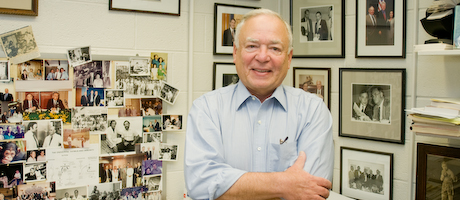By Julia Parmley
In a laboratory at the Albert Einstein College of Medicine of Yeshiva University in New York, Dr. Goldstein, then a postdoctoral student, and his professor Abraham White made a discovery that had the potential to help save the lives of children with deadly immune deficiency diseases and launched a new scientific field.
The year was 1964, and the discovery centered on the isolation of small proteins from the thymus, a gland located below the breast bone and above the heart. The gland’s importance was first discovered in the early 1960s by scientists working with mice. “It was very quickly realized that the thymus gland, which had until that time been thought to be vestigial and without a function, was actually the master gland of the immune system,” says Dr. Goldstein, GW professor of biochemistry and molecular biology. “It is the source of our T-cells, a type of white blood cell, and is critical for our health and growth.”
But the true benefits of the glands potential in humans remained unclear until Drs. Goldstein and White’s discovery of the thymosins. “In the past, it was accepted that children with very rare primary immune deficiency diseases would develop infections and die early in life, but it turns out that some of these children’s illnesses were due in part to the fact that their thymus gland wasn’t functioning and producing these hormone-like molecules,” says Dr. Goldstein. “So, as the mouse studies advanced clinicians were becoming interested in using thymosins to manipulate the immune system. You can do interesting things in the lab with mice, but you have to figure out how to translate that work to humans.”
To make that translation, Dr. Goldstein, by then Director of the division of Biochemistry at The University of Texas Medical Branch (UTMB) at Galveston, Texas, began working with Dr Arthur Ammann, head of the division of Pediatric Immunology at the University of California Medical School in San Francisco (UCSF) to test a thymosin preparation termed thymosin fraction 5 (TF5) on human T-cells in test tubes in 1973.
To increase the supply of the hormone, Dr. Goldstein developed in his lab at UTMB a small pilot plant. In early 1974, after completing extensive safety and pre clinical toxicology studies he received approval from the U.S. Food and Drug Administration to begin clinical trials on humans at UCSF. In April 1974, a five-year-old critically ill girl named Heather became the first person to receive thymosin, which successfully increased her T-cell numbers, improved her immunity and saved her life.
During the years since the thymosins first went into the clinic, Dr. Goldstein helped found a company that commercialized production of two types of thymosins: thymosin alpha 1, which bolsters immune cell activity, and thymosin beta 4, which promotes wound repair and healing. Dr. Goldstein has published over 430 articles and papers to date about the thymosins and the immune system, and collaborates with scientists around the world.
One of these collaborations brought Dr. Goldstein to Catania, Italy, earlier this fall for the Second International Symposium on Thymosins in Health and Disease. Sponsored by GW, the University of Catania and the University of Rome, the conference attracted scientists from around the world, including Japan, Taiwan, Poland, England, Germany and France, to discuss recent developments in the chemistry, biology and clinical applications of thymosins. The first symposium was held at GW in 2007, but Dr. Goldstein says there have been “extraordinary advances” in the field since then, including potential clinical applications to cardiovascular diseases, corneal wound injuries, multiple sclerosis, spinal cord regeneration, hepatitis and cancer.
At the symposium, Dr. Hynda Kleinman, former chief of the cell biology section of the NIH’s National Institute of Dental and Craniofacial Research, and Cardinal Renato Raffaele Martino, president of the Pontifical Council for Justice and Peace, were each given the Abraham White Lifetime Science and Humanitarian Award, for their significant accomplishments in the areas of science and relief work.
The Chair of the Department of Biochemistry & Molecular biology for more than 30 years at the GW Medical School before stepping down this past march, Dr. Goldstein says the basic research work carried out by faculty and students that goes on every day at institutions like GW—can also have an impact on the world.
“Professors are trying to make a difference in the lives of their students by providing them with the mentoring and the tools they need so they too can make a difference, and that’s what I’ve seen with the individuals I work with here,” he says. “One of the nicest things about being a Professor at GW is having the ability to motivate and see the growth of students.”
“Our responsibility as professors is to help our students learn how to use knowledge, the fruit of human intelligence, to make a positive difference in the world,” he adds. “You have to use the gifts you have, and if you have the ability to make a difference, that’s wonderful.”


